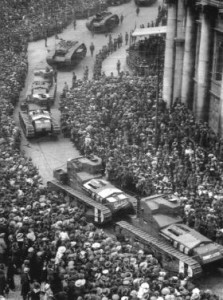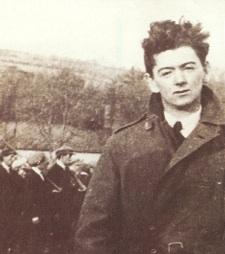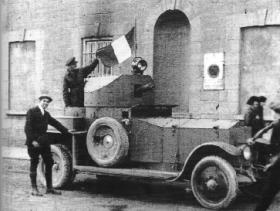Ambushes and armour in the War of Independence: Kilmichael reconsidered
Published in 18th–19th - Century History, Features, Issue 2 (March/April 2010), Volume 18
Tanks were of little use to the British in the Irish War of Independence, aside from the odd demonstration of military might, such as these two Mark IV and four Medium Mark A Whippet tanks in a victory parade in College Green, Dublin, to mark the first anniversary of Armistice Day on 11 November 1919. (George Morrison)
The Irish War of Independence was a war of many firsts: it was the first time that government forces used large numbers of motor vehicles against insurgents; in turn, it was the first time that insurgents conducted an ambush campaign against motor vehicles; finally, it was the first time that government forces ‘up-armoured’ (to use the modern phrase) their vehicles against insurgent threats. These ambushes, then, were a direct IRA response to the specific British advantage of being able to move about almost at will at the outset of the war.
The IRA developed its ambush skills early in the war, ironically from attacks on stationary targets: RIC barracks. While raiding for arms throughout 1919, the Volunteers learned that relief forces arriving on their flanks or rear had disastrous consequences. So they placed scouts to provide early warning of a relief’s approach. When, as they gained more arms, they put larger rear and flank guards out, they discovered the offensive capabilities and the advantages of ambushes: surprise and exploitation of the weakness inherent to military movement. Soon they feigned attacks on barracks just to draw out and ambush relief forces elsewhere. This translated directly to the mobile warfare of the flying columns.
‘Munition strike’ forced British forces onto the roads
The odd ambush during the barracks attack phase was not going to stop British forces, since most of their transport was via the railways for reasons of weight, distances and ease of travel. Fortuitously for the republicans, in May 1920 Dublin dockers began what became known as the ‘munition strike’, which lasted into December of that year. They refused to handle military or police cargo and were joined in short order by the railway workers. This closed rail transport to the army and RIC and forced them onto the roads of Ireland, straining both the motor vehicle supply and the capacity of the roads, both of which were inadequate for the task. It also made these forces’ logistics and movement more vulnerable to IRA attack.
The IRA lost no time exploiting the vulnerabilities of movement as frequency of ambushes increased. While there were increasingly more motor vehicles on the roads, and thus more ‘targets’ for the IRA, the Volunteers were also growing in strength and capability. With each new operation they gained experience, experience which they put to good use. But the British responded to this growing problem, and effectively. For with the closing of the railways to them the British found an unexpected benefit: they were no longer tied logistically to the railways. Obviously there was still a logistical problem; nevertheless, since it would exist no matter where they were, British forces were now capable of greater freedom of movement than they hitherto had been.
British respond with speed and armour
There was still the problem of IRA ambushes, so the British began to develop countermeasures. One of the earliest was speed: driving so fast that the IRA could not stop the vehicles except with luck. Yet speed had drawbacks—innocent civilians could be run down. Nor was it always possible, as convoys could travel only as fast as the slowest vehicle. Then there were driving conditions: less than one-fifth of roads were paved. Finally, Volunteers used the counter-mobility methods they had learnt during their barracks campaign in 1919—felling trees and trenching roads as precursors to ambush.
The threat was significant enough that by May 1920 the Dublin military district spearheaded an effort to provide vehicles with protection. By late summer they found that the most expedient means was to ‘up-armour’ some of their existing vehicle fleet. These lorries, however, would not become available until November and December. They needed to develop other countermeasures in the interim, and the events at Macroom in November made this all too clear.
Auxiliary commander Crake the real architect of Kilmichael

Tom Barry—has received much blame, or praise, for Kilmichael, but the real architect of what occurred was the Auxiliaries’ commander, Francis Crake.
The Kilmichael ambush came at an opportune moment for the IRA. The British did not have large numbers of armoured cars available and their tactical doctrine was in flux. Occurring just a week after Bloody Sunday at Croke Park, the ambush boosted republican morale whilst shocking British forces by the effectiveness and savagery of the engagement.
Debate still rages over the particulars of the attack and the author will not enter that debate here, except to say that neither the British nor the republicans were guilty of crimes or of perfidy with regard to evidence. The known facts of the incident support much of what both sides claim. There are points upon which both sides agree and that are telling for what the British learned from them.
Tom Barry has received much blame or praise, depending on one’s view, for Kilmichael, but the real architect of what occurred was the Auxiliaries’ commander, Francis Crake. His mistakes were amateurish, perhaps arrogant, but certainly the reason he and his men died. From the extant doctrinal view, the lorries were initially properly spaced; but that is about all that Crake got right. He violated every other sensible precaution. Upon meeting the man in the road (Barry), Crake allowed him to approach and there is no evidence that he took significant defensive action. Crake’s death in the first part of the attack was certainly a blow to his now leaderless men.
What should Crake have done? He should have started with a different route than the one so commonly used—route security begins with unpredictability. He failed to use the simplest and most effective countermeasures. Doctrine, prudence and, later, standing orders said that he should have been in the rear of the vehicle to direct his men. Further, his absence from the driving compartment would have allowed an armed lookout to sit there and take action. This forward lookout could have ended the issue almost immediately, for one does not simply throw a bomb without igniting it, during which operation Barry was most vulnerable. Without a front lookout, there was thus a significant gap in the field of fire.

Right: A ‘Royal Naval Pattern’ Rolls Royce armoured car—this one was the first handed over to the Free State Army at Strand Barracks, Limerick, on the eve of the Civil War. (George Morrison)
In addition, Crake should have deployed flank and advance guards as the Crossley halted on seeing the man in the road. The second vehicle should likewise have stopped and immediately deployed flanking and rear guards instead of closing the distance to the first. Thus, almost instantly, there would have been at least a dozen well-armed men taking defensive postures, if not actual defensive positions.
At this point the IRA column would have been in a bad position, Barry being exposed on the road with nowhere to go and his men under strict orders to do nothing until he commenced the attack. Furthermore, it is unlikely that the second lorry would have been within the ambush site when the first lorry stopped. This would place them in a good position to counter-attack IRA positions, which were not entirely mutually supporting. Even if they were within the ambush site, they would still have been in a better position to engage the Volunteers.
This is not to say that these actions would have prevented or halted the ambush, or even have changed the ultimate outcome for the Auxiliaries. It seems quite clear that, with more Auxiliaries able to dismount and counter-attack before coming under effective attack, they would have inflicted greater losses on the Volunteers. The British noted that proper security procedures and convoy formation would have made some difference, but it is unclear whether these would have allowed greater survival versus inflicting greater damage on Barry’s column. Crake’s poor choices made that virtually impossible; clearly, these measures needed to be combined with other developments.
The up-armoured lorries and factory armoured cars began arriving in December. Ireland was given highest priority for the latter by Churchill. They even diverted a shipment of armoured cars en route to Mesopotamia (Iraq) and sent it to Ireland. The IRA had no armour-piercing weapons and Collins’s arms-smuggling network could not get them at any price. So in January 1921 they responded with greater numbers of bombs, but these were of varying quality and success, owing to both manufacture and employment. The Volunteers then returned to their earlier experience and countered the armoured vehicle threat, a technological threat, with simple road-trenching and bridge demolition. This new wave of counter-mobility operations began to tell in May and June, despite British forces’ derision. The army eventually found that it was quicker and safer to travel ‘across’ Ireland via naval destroyer, steaming around the island rather than travelling directly overland. As the British developed their motor vehicle doctrine, the IRA improved their ambush tactics. By midsummer 1921, both sides’ doctrine had matured into effective tactics; then the war ended suddenly. HI
W. H. Kautt is an associate professor at the US Army staff college, Fort Leavenworth, Kansas. The views expressed here are his and do not reflect the official policy or position of the US Army, Department of Defense or the US government.
Further reading:
P. Hart, The IRA and its enemies: violence and community in Cork, 1916–1923 (New York, 1998).
W.H. Kautt, Ambushes and armour: the Irish Rebellion, 1919–1921 (Dublin, 2010).
M. Ryan, Tom Barry: IRA freedom fighter (Cork, 2005).
P. Strickland, ‘The Irish Rebellion in the 6th Divisional Area’, The Irish Sw
















